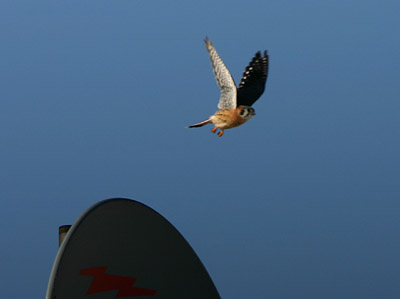Gerald Manley Hopkins, Englishman, Catholic convert, priest, and poet, was born in 1844 and died of typhoid fever in 1889. In between he wrote, taught, and suffered: it seems he was an unhappy man who wrote poems with titles like “I Wake and Feel the Fell of Dark.” Most of his poetry was not published until after his death, including “The Windhover” which was not published until 1918 though it was written in 1877. Oddly for such a depressed person (or perhaps aptly), his last words, uttered on his deathbed, were “I am so happy. I am so happy.”
“The Windhover” is addressed “To Christ Our Lord” and consists first of something that should be near and dear to a birder’s sensibilities, a report of a bird sighting, or, more specifically, a sighting of a windhover (a contraction of windhoverer, an archaic term for the kestrel). Of course, because this report is written in verse it is much nicer to read than a typical report of a sighting and it should be read out loud, mostly because Hopkins liked to write in what he called sprung rhythm, which is meant to imitate patterns of speech.
This seems as good a time as any to put the poem before you and give you a chance to read it. But please read it out loud because it is at least ten times better that way. There are a couple of words that might not be familiar, and I have linked them to their definitions.
The Windhover
To Christ Our Lord
I caught this morning morning’s minion, king-
dom of daylight’s dauphin, dapple-dawn-drawn Falcon, in his riding
Of the rolling level underneath him steady air, and striding
High there, how he rung upon the rein of a wimpling wing
In his ecstasy! then off, off forth on swing,
As a skate’s heel sweeps smooth on a bow-bend the hurl and gliding
Rebuffed the big wind. My heart in hiding
Stirred for a bird — the achieve of; the mastery of the thing!Brute beauty and valour and act, oh, air, pride, plume, here
Buckle! AND the fire that breaks from thee then, a billion
Times told lovelier, more dangerous, O my chevalier!No wonder of it: shéer plód makes plough down sillion
Shine, and blue-bleak embers, ah my dear,
Fall, gall themselves, and gash gold-vermillion.
The first stanza is simply sublime: the pacing, the alliteration, and the sheer sound of it is smooth and simple, it flows into your brain and stays there. One understands why Hopkins’s “heart in hiding / Stirred for a bird.” It is also an amazingly accurate assessment of a kestrel’s hunting strategy. I have, many times, seen a kestrel hover in place facing the wind and searching the field beneath it until it gave up and let the wind sweep it “on swing” until it “Rebuffed the big wind” and started to hover in place again.
The second stanza is where the poem transitions and climaxes and becomes much more ambiguous, particularly in the word “buckle.” First, is buckle referring to the kestrel or to Hopkins? I can’t find any meaning of buckle that would seem to apply to a kestrel in flight so I am left believing that the sight of the “Brute beauty and valour and act, oh, air, pride, plume” caused Hopkins to “here / buckle”. And then is buckle meant literally or metaphorically (did Hopkins, seeing the kestrel’s beauty have his knees buckle under him, or did seeing such beauty make Hopkins metaphorically buckle, that is, was seeing a kestrel a “road to Damascus” moment)? The latter is suggested when one continues reading: it is as if Hopkins dare not write a poem extolling something’s beauty and effect on him without also pointing out how his “chevalier,” is a billion times “lovelier, more dangerous” then the kestrel.
So should we fear “Christ Our Lord” or marvel at his loveliness or what? And is Hopkins getting at the idea that “God is everywhere” and therefore saying that the kestrel is only one small part of God so therefore only a billionth as lovely or dangerous? Either way it bothers me that Hopkins couldn’t just appreciate a bird as a bird without bringing religious claptrap into the poem but I guess that is what I get for reading and writing about a poem written by a priest and dedicated to Christ.
The third stanza returns to one of the themes of the first in that common items, like dawn’s light shining on the dirt turned over by a plow, or the burst of light as a nearly-spent ember breaks open are also lovely and worthy of notice just like the kestrel. Of course, the imagery of the ember breaking open brings back “the fire that breaks from thee” in the previous stanza: once again, the common is not beautiful without religion being brought into it. But the “sillion / Shine” because of “shéer plód” which I interpret as the walking of the person doing the ploughing, which seems to indicate that beauty can be found in the simple, or maybe that God can be found in even in (or especially in?) simple labor.
At this point the ambiguity of the poem makes me want to throw my hands up and give up and so I shall. For a poem that seems simple to start with it turns into a morass of difficult vocabulary (Hopkins even invented a word for this poem, coining “sillion”) and unclear meaning, which, of course, makes it that much more interesting. What does “The Windhover” say to you?
American Kestrel by Mike, not the kestrel Hopkins referred to but a kestrel nonetheless
…
If you liked this post and would like to browse the entire archive of poetry posts on 10,000 Birds please check out our Bird Poems page.
…














This poem definitely channels much of the majesty of a kestrel sighting. I read the last verse through my secular lens as an exultation of the kestrel’s bright coloration (blue-bleak, gold-vermilion).
I always thought Pied Beauty was a bit of a birder’s poem as well: ‘glory be to God for dappled things’ is a sentiment for anyone who has ever admired a nightjar or a sedge warbler or a golden plover.
whoops, my html tags slipped: should be Pied Beauty, obviously.
Thanks for drawing my attention to this poem – it’s exquisite.
I think the best way to characterize his appreciation of the Kestrel is not that he dismisses the Kestrel to dwell on Christ, but that he sees the glory of Christ in the Kestrel itself. So the Kestrel’s never completely left behind (hence drawing from blue-beak to describe embers), but transcended because he found something more lasting and important to consider within it.
In the same way, you can find Christ in daily work – so the poem ends practically. The “whee” moments of life might be found in the brief revelation of Christ’s fire in the glimpse of an inspiring bird, but also in the rest of our life, where Christ’s blood (gash gold-vermilion) is at work sanctifying us.
So, the poem could be used as an argument for birding as a hobby. Why go to work when you’d rather be birding? Why go birding when it has nothing to do with your work?
As a Christian, I find it especially satisfying. I think non-Christians could find some meaning in it, too, depending on how you comprehend the existence of sublimity.
An interesting aside, in Hopkins’ manuscript, “dapple-dawn-drawn” does not include the hyphens. What Hopkins wrote was “dappledawndrawn”. The publisher added the hyphens.
“Buckle” in this context means “to prepare for action”. The Kestrel is “morning’s minion” and it’s heir, or “dauphin”. I think this poem is about beginning a task.
If you want a Christian interpretaion, I see the crucified Christ preparing himself for the end. The allusion of the plough, with a “shine” from being used, as in “swords to ploughshears”, contrasts nicely at the end to the violent death of Christ.
The bird is a metaphor for Christ and if you take this out, it is incoherent. The bird plunges but then rises again, the way Christ falls [into death, human misery, what you will] and resurrects. It is in resurrection that the fire breaks and is more dangerous – it is then that Christ becomes a chevalier, so protects and redeems us.
Hopkins then elaborates this idea in the last three lines. The sheer plod is a fall, a stamp in the earth, but from the sillion (the track between furrows) life springs back again, in glory. Then, take the dark materiality of the embers – they “fall” into the fire and ‘gash’ gold vermilion, the colours of fire and blood. In falling they are fulfilled and reborn as flame.
Interesting thoughts on the poem. I thoroughly enjoyed the insights. I was puzzled, however, by your annoyance of Hopkins bringing religion into the poem. God who created the bird is much more facinating than the bird. I wouldn’t have chided you for bringing up Hopkins as the amazing author of the poem anymore than I would criticize him for appreciating God-whose creation always points back to Him and His redemption plan for mankind
There is also the idea that even a humble task (plodding behind a plough) or an unprepossessing ember conceal splendour: the friction of the soil polishes the plough, the “blue-bleak” ember has an inner magnificence – “gold vermilion”. Aren’t these images for the notion that the windhover is the vehicle for something incalculably greater than itself, namely it’s creator?
Hopkins’ gift is allowing us non deists some insight into his religious “ecstasy”. By annealing the power of exquisite poetry, intellect and language to his religious imagery we comprehend, accept and meld.
Don Horn